History of Libya
| History of Libya | ||||||
|---|---|---|---|---|---|---|
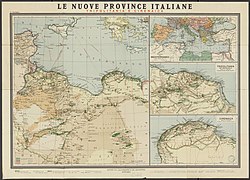 | ||||||
|
||||||
|
| ||||||
Libya's history involves its rich mix of ethnic groups, including the indigenous Berbers/Amazigh people. Amazigh have been present throughout the entire history of the country. For most of its history, Libya has been subjected to varying degrees of foreign control, from Europe, Asia, and Africa.
The history of Libya comprises six distinct periods: Ancient Libya, the Roman era, the Islamic era, Ottoman rule, Italian rule, and the Modern era.
Prehistoric and Berber Libya

Tens of thousands of years ago, the
Egyptian inscriptions from the
The onset of the
The African ancestors of the
Phoenician and Greek Libya

The Phoenicians were some of the first to establish coastal trading posts in Libya, when the merchants of
In 630 BCE, the
Achaemenid and Ptolemaic Libya
In 525 BCE the Persian army of Cambyses II overran Cyrenaica, which for the next two centuries remained under Persian or Egyptian rule. Alexander was greeted by the Greeks when he entered Cyrenaica in 331 BCE, and Eastern Libya again fell under the control of the Greeks, this time as part of the Ptolemaic Kingdom. Later, a federation of the Pentapolis was formed that was customarily ruled by a king drawn from the Ptolemaic royal house.
Roman Libya
After the fall of
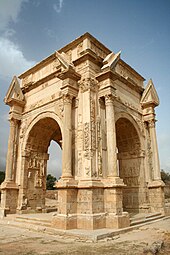
Regardless, for more than 400 years Tripolitania and Cyrenaica were part of a cosmopolitan state whose citizens shared a common language, legal system, and Roman identity. Roman ruins like those of Leptis Magna and Sabratha, extant in present-day Libya, attest to the vitality of the region, where populous cities and even smaller towns enjoyed the amenities of urban life—the forum, markets, public entertainments, and baths—found in every corner of the Roman Empire. Merchants and artisans from many parts of the Roman world established themselves in North Africa, but the character of the cities of Tripolitania remained decidedly Punic and, in Cyrenaica, Greek. Tripolitania was a major exporter of olive oil,[13] as well as a center for the trade of ivory and wild animals[13] conveyed to the coast by the Garamantes, while Cyrenaica remained an important source of wines, drugs, and horses. The bulk of the population in the countryside consisted of Berber farmers, who in the west were thoroughly "romanized" in language and customs.[14] Until the 10th century the African Romance remained in use in some Tripolitanian areas, mainly near the Tunisian border.[15]
The decline of the Roman Empire saw the classical cities fall into ruin, a process hastened by the Vandals' destructive sweep though North Africa in the 5th century. The region's prosperity had shrunk under Vandal domination, and the old Roman political and social order, disrupted by the Vandals, could not be restored. In outlying areas neglected by the Vandals,[16] the inhabitants had sought the protection of tribal chieftains and, having grown accustomed to their autonomy, resisted re-assimilation into the imperial system.[16]
When the Empire returned (now as
Islamic Libya

Tenuous
For the next several decades, Libya was under the purview of the Umayyad

Zirid rule in Tripolitania was short-lived though, and already in 1001 the Berbers of the
Ottoman Libya

After a successful invasion by the
In time, real power came to rest with the pasha's corps of

Tripoli was the only city of size in Ottoman Libya (then known as Tripolitania
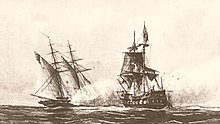
Lacking direction from the Ottoman government, Tripoli lapsed into a period of military anarchy during which coup followed coup and few deys survived in office more than a year. One such
In the early 19th century war broke out between the United States and Tripolitania, and a series of battles ensued in what came to be known as the First Barbary War and the Second Barbary War. By 1819, the various treaties of the Napoleonic Wars had forced the Barbary states to give up piracy almost entirely, and Tripolitania's economy began to crumble. As Yusuf weakened, factions sprung up around his three sons; though Yusuf abdicated in 1832 in favor of his son Ali II, civil war soon resulted. Ottoman Sultan Mahmud II sent in troops ostensibly to restore order, but instead deposed and exiled Ali II, marking the end of both the Karamanli dynasty and an independent Tripolitania.[27] Anyway, order was not recovered easily, and the revolt of the Libyan under Abd-El-Gelil and Gûma ben Khalifa lasted until the death of the latter in 1858.[27]
The second period of direct Ottoman rule saw administrative changes, and what seemed as greater order in the governance of the three provinces of Libya. It would not be long before the Scramble for Africa and European colonial interests set their eyes on the marginal Turkish provinces of Libya. The Ottoman Sultan Abdulhamid II twice sent his aide-de-camp Azmzade Sadik El Mueyyed to meet Sheikh Senussi to cultivate positive relations and counter the West European scramble for Africa.[28] Reunification came about through the unlikely route of an invasion (Italo-Turkish War, 1911–1912) and occupation starting from 1911 when Italy simultaneously turned the three regions into colonies.[29]
Italian Libya

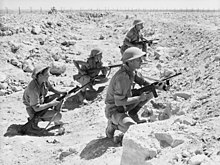
From 1912 to 1927, the territory of Libya was known as
In 1934, Italy adopted the name "Libya" (used by the Greeks for all of North Africa, except Egypt) as the official name of the colony (made up of the three provinces of Cyrenaica, Tripolitania and Fezzan). Idris al-Mahdi as-Senussi (later King Idris I), Emir of Cyrenaica, led Libyan resistance to Italian occupation between the two world wars.
In 1934, the political entity called "Libya" was created by governor Balbo with capital Tripoli.[33] The Italians emphasized infrastructure improvements and public works. In particular, they hugely expanded Libyan railway and road networks from 1934 to 1940, building hundreds of kilometers of new roads and railways and encouraging the establishment of new industries and dozens of new agricultural villages.
During
From 1943 to 1951, Tripolitania and Cyrenaica were under
Kingdom

On 21 November 1949, the UN General Assembly passed a resolution stating that Libya should become independent before 1 January 1952. Idris represented Libya in the subsequent UN negotiations. On 24 December 1951, Libya declared its independence as the United Kingdom of Libya, a constitutional and hereditary monarchy under King Idris, Libya's only monarch.
1951 also saw the enactment of the
The enactment of the Libyan Constitution was significant in that it was the first piece of legislation to formally entrench the rights of Libyan citizens following the post-war creation of the Libyan nation state. Following on from the intense UN debates during which Idris had argued that the creation of a single Libyan state would be of benefit to the regions of Tripolitania, Fezzan, and Cyrenaica, the Libyan government was keen to formulate a constitution which contained many of the entrenched rights common to European and North American nation states. Though not creating a secular state – Article 5 proclaims Islam the religion of the State – the Libyan Constitution did formally set out rights such as equality before the law as well as equal civil and political rights, equal opportunities, and an equal responsibility for public duties and obligations, "without distinction of religion, belief, race, language, wealth, kinship or political or social opinions" (Article 11).
During this period, Britain was involved in extensive engineering projects in Libya and was also the country's biggest supplier of arms. The United States also maintained the large Wheelus Air Base in Libya.[36]
Arab Republic and Jamahiriya
On 1 September 1969, a small group of military officers led by 27-year-old army officer
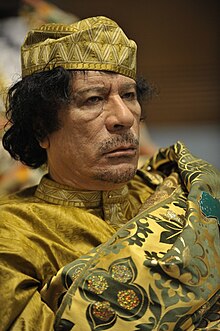
On the birthday of Muhammad in 1973, Gaddafi delivered a "Five-Point Address". He announced the suspension of all existing laws and the implementation of Sharia. He said that the country would be purged of the "politically sick". A "people's militia" would "protect the revolution". There would be an administrative revolution, and a cultural revolution. Gaddafi set up an extensive surveillance system. 10 to 20 percent of Libyans worked in surveillance for the Revolutionary committees, which monitored activities in government, in factories, and in the education sector.[39] Gaddafi executed dissidents publicly and the executions were often rebroadcast on state television channels.[39][40] Gaddafi employed his network of diplomats and recruits to assassinate dozens of critical refugees around the world. Amnesty International listed at least 25 assassinations between 1980 and 1987.[39][41]

In 1977, Libya officially became the "Great Socialist People's Libyan Arab Jamahiriya". Gaddafi officially passed power to the
From 1977 onward, per capita income in the country rose to more than US$11,000, the fifth-highest in Africa,
Gaddafi doubled the minimum wage, introduced statutory price controls, and implemented compulsory rent reductions of between 30 and 40%. Gaddafi also wanted to combat the strict social restrictions that had been imposed on women by the previous regime, establishing the
Gaddafi assumed the honorific title of "King of Kings of Africa" in 2008 as part of his campaign for a United States of Africa.[56] By the early 2010s, in addition to attempting to assume a leadership role in the African Union, Libya was also viewed as having formed closer ties with Italy, one of its former colonial rulers, than any other country in the European Union.[57] The eastern parts of the country have been "ruined" due to Gaddafi's economic theories, according to The Economist.[58][59]
2011 uprising and the First Civil War

After popular movements overturned the rulers of Tunisia and Egypt, its immediate neighbors to the west and east, Libya experienced a full-scale revolt beginning on 17 February 2011.[60] By 20 February, the unrest had spread to Tripoli. In the early hours of 21 February 2011, Saif al-Islam Gaddafi, oldest son of Muammar Gaddafi, spoke on Libyan television of his fears that the country would fragment and be replaced by "15 Islamic fundamentalist emirates" if the uprising engulfed the entire state. He admitted that "mistakes had been made" in quelling recent protests and announced plans for a constitutional convention, but warned that the country's economic wealth and recent prosperity was at risk and warned of "rivers of blood" if the protests continued.[61][62]
On 27 February 2011, the
By early March 2011, some parts of Libya had tipped out of Gaddafi's control, coming under the control of a coalition of opposition forces, including soldiers who decided to support the rebels. Eastern Libya, centered on the port city of Benghazi, was said to be firmly in the hands of the opposition, while Tripoli and its environs remained in dispute.[67][68][69] Pro-Gaddafi forces were able to respond militarily to rebel pushes in Western Libya and launched a counterattack along the coast toward Benghazi, the de facto centre of the uprising.[70] The town of Zawiya, 48 kilometres (30 mi) from Tripoli, was bombarded by Air Force planes and Army tanks and seized by Jamahiriya troops, "exercising a level of brutality not yet seen in the conflict".[71]
In several public appearances, Gaddafi threatened to destroy the protest movement, and
On 17 March 2011 the UN Security Council passed Resolution 1973 with a 10–0 vote and five abstentions. The resolution sanctioned the establishment of a no-fly zone and the use of "all means necessary" to protect civilians within Libya.[81]
Shortly afterwards, Libyan Foreign Minister Moussa Koussa stated that "Libya has decided an immediate ceasefire and an immediate halt to all military operations".[82]
On 19 March, the first Allied act to secure the no-fly zone began when French military jets entered Libyan airspace on a
On 27 June 2011, the International Criminal Court issued an arrest warrant for Gaddafi, alleging that Gaddafi had been personally involved in planning and implementing "a policy of widespread and systematic attacks against civilians and demonstrators and dissidents".[85]

By 22 August 2011, rebel fighters had entered Tripoli and occupied Green Square,[86] which they renamed to its original name, Martyrs' Square in honour of those killed during the Italian occupation. Meanwhile, Gaddafi asserted that he was still in Libya and would not concede power to the rebels.[86]
On 16 September 2011, the U.N. General Assembly approved a request from the National Transitional Council to accredit envoys of the country's interim controlling body as Tripoli's sole representatives at the UN, effectively recognising the National Transitional Council as the legitimate holder of that country's UN seat.[87]
The National Transitional Council had been plagued by internal divisions during its tenure as Libya's interim governing authority. It postponed the formation of a caretaker, or "interim" government on several occasions during the period prior to the
The "
Transition and the Second Civil War
After the First Civil War, the National Transitional Council (NTC) has been responsible for the transition of the administration of the governing of Libya. The "liberation" of Libya was celebrated on 23 October 2011. Then Jibril announced that consultations were under way to form an interim government within one month, followed by elections for a constitutional assembly within eight months and parliamentary and presidential elections to be held within a year after that. He stepped down as expected the same day and was succeeded by Ali Tarhouni.
On 24 November, Tarhouni was replaced by Abdurrahim El-Keib. El-Keib formed a provisional government, filling it with independent or CNT politicians, including women.
After the fall of Gaddafi, Libya has been faced with internal struggles. A protest started against the new regime of NTC.[clarification needed] The loyalists of Gaddafi rebelled and fought with the new Libyan army.[clarification needed]
Because the
On 7 July 2012, Libyans voted in their first parliamentary elections since the end of Gaddafi's rule. The election, in which more than 100 political parties registered, formed an interim 200-member national assembly. This will replace the unelected National Transitional Council,[94][95] name a prime minister, and form a committee to draft a constitution. The vote was postponed several times to resolve logistical and technical problems, and to give more time to register to vote, and to investigate candidates.[96]
On 8 August 2012, the National Transitional Council officially handed power to the wholly elected General National Congress, which is tasked with the formation of an interim government and the drafting of a new Libyan Constitution to be approved in a general referendum.[97]
On 25 August 2012, in what "appears to be the most blatant sectarian attack" since the end of the civil war, unnamed organized assailants bulldozed a Sufi mosque with graves, in broad daylight in the center of the Libyan capital Tripoli. It was the second such razing of a Sufi site in two days.[98]
On 7 October 2012, Libya's Prime Minister-elect
On 30 March 2014 General National Congress voted to replace itself with new House of Representatives.[105]
As of 18 May 2014[update], the parliament building was
On 14 July, the
In December 2015, the
On 4 April 2019,
On 23 October 2020, the 5+5 Joint Libyan Military Commission representing the Libyan National Army and the GNA reached a "permanent ceasefire agreement in all areas of Libya". The agreement, effective immediately, required that all foreign fighters leave Libya within three months while a joint police force would patrol disputed areas. The first commercial flight between Tripoli and Benghazi took place that same day.[118][119] On 10 March 2021, an interim unity government was formed, which was slated to remain in place until the next Libyan presidential election scheduled for 10 December.[120] However, the election has been delayed several times[121][122][123] since, effectively rendering the unity government in power indefinitely, causing tensions which threaten to reignite the war.
On September 10, 2023, catastrophic floods due to dam failures generated by Storm Daniel devastated the port city of Derna, killing nearly 7,000 and leaving over 10,000 missing. The floods were the worst natural disaster in Libya's modern history.[124]
See also
- Arab Spring
- History of North Africa
- History of the Jews in Libya
- List of heads of state of Libya
- Military history of Libya
- Politics of Libya
- Tripoli history and timeline
- Benghazi history and timeline
Notes
- ^ Federal Research Division of the Library of Congress, (1987), "Early History of Libya" Archived 22 September 2012 at archive.today, U.S. Library of Congress. Retrieved 11 July 2006.
- OCLC 988848424.
- ^ Oliver, Roland (1999), The African Experience: From Olduvai Gorge to the 21st Century (Series: History of Civilization), London: Phoenix Press, revised edition, pg 39.
- ^ Herodotus, (c.430 BCE), "'The Histories', Book IV.42–43" Archived 9 April 2013 at the Wayback Machine Fordham University, New York. Retrieved 18 July 2006.
- ^ Federal Research Division of the Library of Congress, (1987), "Tripolitania and the Phoenicians" Archived 22 September 2012 at archive.today, U.S. Library of Congress. Retrieved 11 July 2006.
- ^ Federal Research Division of the Library of Congress, (1987), "Cyrenaica and the Greeks" Archived 22 September 2012 at archive.today, U.S. Library of Congress. Retrieved 11 July 2006.
- ^ History of Libya Archived 28 January 2013 at the Wayback Machine, The History Files. Retrieved 29 September 2011
- ^ a b c d e Bertarelli (1929), p. 202.
- ^ a b c d Bertarelli (1929), p. 417.
- ^ Bertarelli (1929), p. 382.
- ^ a b Rostovtzeff (1957), p. 364.
- ^ Cassius Dio, lxviii. 32
- ^ a b Rostovtzeff (1957), p. 335.
- ^ Heuser, Stephen, (24 July 2005), "When Romans lived in Libya" Archived 14 November 2012 at the Wayback Machine, The Boston Globe. Retrieved 18 July 2006.
- ^ Tadeusz Lewicki, "Une langue romane oubliée de l'Afrique du Nord. Observations d'un arabisant", Rocznik Orient. XVII (1958), pp. 415–480.
- ^ OCLC 58549764.
- ^ Rodd, Francis. "Kahena, Queen of the Berbers: A Sketch of the Arab Invasion of Ifrikiya in the First Century of the Hijra" Bulletin of the School of Oriental Studies, University of London, Vol. 3, No. 4, (1925), 731–2
- ^ a b Bertarelli (1929), p. 278.
- ISBN 0-571-21591-2.
- ^ "Populations Crises and Population Cycles Archived 27 May 2013 at the Wayback Machine", Claire Russell and W.M.S. Russell.
- ^ a b c d e Bertarelli (1929), p. 203.
- ^ المؤلف : الطاهر أحمد الزاوي (28 March 2018). ولاة طرابلس من بداية الفتح العربي إلى نهاية العهد التركي.
- ISBN 9780292719224.
One of the most famous corsairs was Turghut (Dragut) (?–1565), who was of Greek ancestry and a protégé of Khayr al-Din. ... While pasha, he built up Tripoli and adorned it, making it one of the most impressive cities along the North African littoral.
- ^ a b c d e Bertarelli (1929), p. 204.
- ISBN 978-0-333-71966-4. Retrieved 31 May 2012.
- ^ Lisa Anderson, "Nineteenth-Century Reform in Ottoman Libya" Archived 10 October 2016 at the Wayback Machine, International Journal of Middle East Studies, Vol. 16, No. 3. (August 1984), pp. 325–348.
- ^ a b Bertarelli (1929), p. 205.
- ISBN 978-1-7371298-8-2.
- ^ Country Profiles, (16 May 2006), "Timeline: Libya, a chronology of key events" Archived 23 October 2011 at the Wayback Machine BBC News. Retrieved 18 July 2006.
- ^ Libya Archived 30 April 2013 at the Wayback Machine, Encyclopædia Britannica.
- ISBN 0-415-21409-2, p. 26.
- ^ "Un patriota della Cirenaica". retedue.rsi.ch. 1 March 2011. Archived from the original on 11 May 2011. Retrieved 24 March 2011.
- ^ "Italian Tripoli". Archived from the original on 6 March 2019. Retrieved 6 March 2019.
- ^ Hagos, Tecola W., (20 November 2004), "Treaty Of Peace With Italy (1947), Evaluation And Conclusion" Archived 7 December 2012 at the Wayback Machine, Ethiopia Tecola Hagos. Retrieved 18 July 2006.
- ^ Chronology of International Events and Documents, Royal Institute of International Affairs. Vol. 7, No. 8 (5–18 April 1951), pp. 213–244
- ^ Holger Terp. "Fredsakademiet: Freds- og sikkerhedspolitisk Leksikon L 170 : Libya During the Cold War". Fredsakademiet.dk. Archived from the original on 31 December 2012. Retrieved 23 December 2012.
- ^ Salak, Kira. "Rediscovering Libya". National Geographic Adventure. Archived from the original on 23 September 2011.
- ^ US Department of State's Background Notes, (November 2005) "Libya – History" Archived 4 June 2019 at the Wayback Machine, U.S. Dept. of State. Retrieved 14 July 2006.
- ^ a b c Mohamed Eljahmi (2006). "Libiya and the U.S.: Qadhafi Unrepentant". The Middle East Quarterly. Archived from the original on 25 January 2013. Retrieved 4 February 2013.
- ^ Brian Lee Davis. Qaddafi, terrorism, and the origins of the U.S. attack on Libya.
- ^ The Middle East and North Africa 2003 (2002). Eur. p. 758
- ^ Wynne-Jones, Jonathan (19 March 2011). "Libyan minister claims Gaddafi is powerless and the ceasefire is 'solid'". The Daily Telegraph. London. Archived from the original on 29 October 2011. Retrieved 22 October 2011.
- ^ Eljahmi, Mohamed (2006). "Libya and the U.S.: Qadhafi Unrepentant". Middle East Quarterly. Archived from the original on 25 January 2013. Retrieved 4 February 2013.
- ^ Robbins, James (7 March 2007). "Eyewitness: Dialogue in the desert". BBC News. Retrieved 22 October 2011.
- ^ "Libya country update". European Forum. Archived from the original on 18 May 2011.
- ^ "Egypt Libya War 1977". Onwar.com. Archived from the original on 24 March 2012. Retrieved 23 December 2012.
- ^ "Endgame in Tripoli". The Economist. 24 February 2011. Archived from the original on 7 March 2011. Retrieved 4 February 2013.
- ^ Geoffrey Leslie Simons. Libya: the struggle for survival. p. 281.
- ^ St. John, Ronald Bruce (1 December 1992). "Libyan terrorism: the case against Gaddafi". Contemporary Review. Archived from the original on 25 May 2017. Retrieved 4 February 2013.
- ^ "A Rogue Returns". AIJAC. February 2003. Archived from the original on 11 May 2011.
- ^ "African Countries by GDP Per Capita > GDP Per Capita (most recent) by Country". NationMaster. Archived from the original on 16 July 2011. Retrieved 24 July 2011.
- ^ a b Azad, Sher (22 October 2011). "Gaddafi and the media". Daily News. Archived from the original on 14 November 2012. Retrieved 22 October 2011.
- AllAfrica.com. 21 July 2011. Archivedfrom the original on 7 November 2011. Retrieved 23 October 2011.
- ^ Shimatsu, Yoichi (21 October 2011). "Villain or Hero? Desert Lion Perishes, Leaving West Explosive Legacy". New America Media. Archived from the original on 22 October 2011. Retrieved 23 October 2011.
- ^ Bearman, Jonathan (1986). Qadhafi's Libya. London: Zed Books
- ^ "Gaddafi: Africa's 'king of kings'". BBC News. 29 August 2008. Archived from the original on 30 June 2017. Retrieved 27 February 2011.
- ^ Schlamp, Hans-Jürgen (25 February 2011). "Kissing the Hand of the Dictator: What Libya's Troubles Mean for Its Italian Allies". Der Spiegel. Archived from the original on 28 February 2011. Retrieved 27 February 2011.
- ^ "A civil war beckons". The Economist. 3 March 2011. Archived from the original on 20 February 2013. Retrieved 4 February 2013.
- ^ "The liberated east – Building a new Libya". The Economist. 24 February 2011. Archived from the original on 27 February 2011. Retrieved 4 February 2013.
- ^ "Live Blog – Libya". Al Jazeera. 17 February 2011. Archived from the original on 23 February 2011. Retrieved 23 February 2011.
- ^ "Libya: Saif al-Islam Gaddafi's defiant speech". The Daily Telegraph. London. 21 February 2011. Archived from the original on 24 February 2011. Retrieved 24 October 2011.
- ^ "Gaddafi's son warns of "rivers of blood" in Libya". Al Arabiya. 21 February 2011. Archived from the original on 2 November 2011. Retrieved 24 October 2011.
- ^ "Ex Libyan minister forms interim govt-report". LSE. 26 February 2011. Archived from the original on 13 May 2011. Retrieved 27 February 2011.
- Al Jazeera. Archivedfrom the original on 27 August 2019. Retrieved 27 August 2019.
- ^ "The Council"International Recognition". National Transitional Council (Libya). 1 March 2011. Archived from the original on 26 September 2011. Retrieved 23 October 2011.
- ^ "Libya: France recognises rebels as government". BBC News. 10 March 2011. Archived from the original on 23 October 2011. Retrieved 23 October 2011.
- ^ "Protesters march in Tripoli". Al Jazeera. 28 February 2011. Archived from the original on 5 November 2012. Retrieved 1 March 2011.
- ^ "Libya: France recognises rebels as government". BBC News. 10 March 2011. Archived from the original on 23 October 2011. Retrieved 20 June 2018.
- ^ The Guardian Live Blog Archived 22 August 2017 at the Wayback Machine. Retrieved 10 March 2011
- ^ Fahim, Kareem; Kirkpatrick, David D. (9 March 2011). "Qaddafi Forces Batter Rebels in Strategic Refinery Town". The New York Times. Archived from the original on 6 May 2011. Retrieved 9 March 2011.
- ^ The Independent, 9 March 2011 P.4
- ^ "Gaddafi vows to crush protesters". Al Jazeera. 25 February 2011. Archived from the original on 2 December 2011. Retrieved 26 February 2011.
- ^ "Ban Ki-moon blasts Gaddafi; calls situation dangerous". Hindustan Times. 24 February 2011. Archived from the original on 27 February 2011. Retrieved 26 February 2011.
- ^ "Some backbone at the U.N." Los Angeles Times. 26 February 2011. Archived from the original on 3 March 2011. Retrieved 26 February 2011.
- ^ "Libya Expelled from UN Human Rights Council". Sofia News Agency. 2 March 2011. Archived from the original on 11 May 2011. Retrieved 2 March 2011.
- ^ "US slaps sanctions on Libyan govt". Al Jazeera. 26 February 2011. Archived from the original on 3 January 2012. Retrieved 26 February 2011.
- ^ "Australia imposes sanctions on Libya". The Sydney Morning Herald. 27 February 2011. Archived from the original on 28 February 2011. Retrieved 27 February 2011.
- ^ "Canada imposes additional Libyan sanctions". CBC News. 27 February 2011. Archived from the original on 1 March 2011. Retrieved 28 February 2011.
- ^ "UN Security Council orders sanctions against Libya". Monsters & Critics. 27 February 2011. Archived from the original on 27 February 2011. Retrieved 27 February 2011.
- ^ "U.N. Security Council slaps sanctions on Libya". NBC News. 26 February 2011. Retrieved 27 February 2011.
- ^ "Security Council authorizes 'all necessary measures' to protect civilians in Libya". United Nations News Service. 17 March 2011. Archived from the original on 3 May 2011. Retrieved 30 March 2011.
- ^ "Libya: Pro-Gaddafi forces 'to observe ceasefire'". BBC News. 18 March 2011. Archived from the original on 23 April 2018. Retrieved 20 June 2018.
- ^ a b Jonathan Marcus (19 March 2011). "French military jets open fire in Libya". BBC News. Archived from the original on 20 March 2011. Retrieved 20 August 2011.
- ^ "Coalition launches Libya attacks". BBC. 19 March 2011. Archived from the original on 20 March 2011. Retrieved 20 March 2011.
- ^ Ian Black and David Smith (27 June 2011). "War crimes court issues Gaddafi arrest warrant". The Guardian. Tripoli. Archived from the original on 30 September 2013. Retrieved 20 August 2011.
- ^ a b Erdbrink, Thomas; Sly, Liz. "In Libya, Moammar Gaddafi's rule crumbling as rebels enter heart of Tripoli". The Washington Post.
- ^ Jennifer Welsh (20 September 2011). "Recognizing States and Governments–A Tricky Business". Canadian International Council. Archived from the original on 27 September 2011. Retrieved 23 October 2011.
- ^ Fahim, Kareem (20 October 2011). "Qaddafi Is Dead, Libyan Officials Say". The New York Times. Archived from the original on 20 October 2011. Retrieved 20 October 2011.
- ^ "Muammar Gaddafi killed as Sirte falls". Al Jazeera. 21 October 2011. Archived from the original on 23 October 2011. Retrieved 23 October 2011.
- ^ Vivienne Walt (19 October 2011). "In Tripoli, Libya's Interim Leader Says He Is Quitting". Time. Archived from the original on 22 October 2011. Retrieved 23 October 2011.
- ^ "Libya Declares Liberation From 42-Year Gadhafi Rule". Voice of America. 2011. Archived from the original on 25 October 2011. Retrieved 23 October 2011.
- ^ Daragahi, Borzou (23 October 2011). "Libya declares liberation after Gaddafi's death". Financial Times. Archived from the original on 10 December 2022. Retrieved 23 October 2011.
- ^ Karin Laub (8 September 2011). "Libyan estimate: At least 30,000 died in the war". The Guardian. Associated Press. Archived from the original on 4 November 2013. Retrieved 25 November 2011.
- ^ Cousins, Michel (24 July 2012). "National Congress to meet on 8 August: NTC". Libya Herald. Retrieved 26 July 2012.
- ^ "NTC to Transfer Power to Newly-Elected Libyan Assembly August 8". Tripoli Post. 2 August 2012. Archived from the original on 7 August 2012. Retrieved 4 August 2012.
- ^ "In Libya, Expectations High as Parliamentary Vote Approaches". PBS NewsHour. 5 July 2012. Archived from the original on 27 March 2019. Retrieved 8 March 2019.
- ^ Esam Mohamed (8 August 2012). "Libya's transitional rulers hand over power". Boston.com. Associated Press. Archived from the original on 8 December 2012. Retrieved 8 August 2012.
- ^ "(Reuters by Yahoo News)". Archived from the original on 27 August 2012. Retrieved 14 January 2017.
- ^ George Grant (7 October 2012). "Congress dismisses Abushagur". Retrieved 7 October 2012.
- ^ Sami Zaptia (7 October 2012). "Abushagur announces a smaller emergency cabinet". Retrieved 7 October 2012.
- ^ "Libyan Prime Minister Mustafa Abu Shagur to stand down". BBC News. BBC. 7 October 2012. Archived from the original on 7 October 2012. Retrieved 7 October 2012.
- ^ "Libya Congress elects former congressman and rights lawyer Ali Zidan as new prime minister". The Washington Post. 14 October 2012. Archived from the original on 15 October 2012. Retrieved 14 October 2012.
- ^ David D Kirkpatrick (17 March 2014). "U.S. Navy SEALs Take Control of Diverted Oil Tanker". The New York Times. Archived from the original on 21 March 2014. Retrieved 17 March 2014.
- ^ "Libya ex-PM Zeidan 'leaves country despite travel ban'". BBC. 12 March 2014. Archived from the original on 15 March 2014. Retrieved 16 March 2014.
- ^ "Congress votes to replace itself with new House of Representatives". Libya Herald. 30 March 2014. Archived from the original on 30 September 2017. Retrieved 1 April 2014.
- ^ Frizell, Sam (13 April 2014). "Libya PM Quits, Says He Was Targeted in Armed Attack". Time. Archived from the original on 31 May 2014. Retrieved 14 April 2014.
- ^ "Maetig accepts Supreme Court ruling and resigns". Libya Herald. 9 June 2014. Archived from the original on 11 June 2014. Retrieved 9 June 2014.
- ^ "Rogue General's Troops Storm Libyan Parliament". Sky News. 18 May 2014. Archived from the original on 19 May 2014. Retrieved 26 July 2014.
- ^ "Gunfire erupts outside Libyan parliament". Al Jazeera. 18 May 2014. Archived from the original on 18 May 2014. Retrieved 26 July 2014.
- ^ Fiona Keating (18 May 2014). "Libya: Rogue General Khalifa Haftar Storms Parliament in Attempted 'Coup'". International Business Times. Archived from the original on 19 May 2014. Retrieved 26 July 2014.
- ^ Al-Warfalli, Ayman; Bosalum, Feras (14 July 2014). "U.N. pulls staff out of Libya as clashes kill 13, close airports". Reuters. Archived from the original on 14 July 2014. Retrieved 14 July 2014.
- ^ a b New rocket attack on Tripoli airport Archived 12 August 2018 at the Wayback Machine BBC News. 15 July 2014.
- ^ "UN welcomes 'historic' signing of Libyan Political Agreement". UN. 17 December 2015.
- ^ Stephen, Chris (30 March 2016). "Chief of Libya's new UN-backed government arrives in Tripoli". The Guardian. Retrieved 28 December 2018.
- from the original on 6 April 2019. Retrieved 6 April 2019.
- ^ "Libya army leader Khalifa Haftar orders forces to march on Tripoli". Los Angeles Times. 4 April 2019. Archived from the original on 6 April 2019. Retrieved 6 April 2019.
- ^ Mohareb, Hatem; Sarrar, Saleh; Al-Atrush, Samer (6 April 2019). "Libya Lurches Toward Battle for Capital as Haftar Advances". Bloomberg. Archived from the original on 6 April 2019. Retrieved 6 April 2019.
- ^ Nebehay, Stephanie; McDowall, Angus (23 October 2020). Jones, Gareth; Maclean, William (eds.). "Warring Libya rivals sign truce but tough political talks ahead". Reuters. Retrieved 23 October 2020.
- ^ "UN says Libya sides reach 'permanent ceasefire' deal". Al Jazeera. 23 October 2020. Retrieved 23 October 2020.
- ^ "Libyan lawmakers approve gov't of PM-designate Dbeibah". Al Jazeera. 10 March 2021. Retrieved 10 March 2021.
- ^ "Libya electoral commission dissolves poll committees". www.aljazeera.com. Retrieved 21 December 2021.
- ^ AfricaNews (17 January 2022). "UN: Libya elections could be held in June". Africanews. Retrieved 23 January 2022.
- ^ "Libya's PM Dbeibah proposes holding polls at end of 2022". Daily Sabah. 26 May 2022. Retrieved 14 June 2022.
- ^ Elumami, Ahmed; Al-Warfali, Ayman; Alfetori, Essam (14 September 2023). "Libya floods: search for blame for thousands of deaths". Reuters.
Bibliography
- ISBN 0-8108-5303-5.
- Chapin Metz, Helen, ed. (1987). Libya: A Country Study. Washington: GPO for the Library of Congress.
- Nelson, Harold D.; Nyrop, Richard F. (1987). Libya: A Country Study. OCLC 5676518.
- Wright, John L. (1969). Nations of the Modern World: Libya. Ernest Benn Ltd.
- Bertarelli, L.V. (1929). Guida d'Italia (in Italian). Vol. XVII. Milano: Consociazione Turistica Italiana.
- Tuccimei, Ercole (1999). La Banca d'Italia in Africa, Foreword by Arnaldo Mauri, Laterza, Bari.
- Pierre Schill, Réveiller l’archive d’une guerre coloniale. Photographies et écrits de Gaston Chérau, correspondant de guerre lors du conflit italo-turc pour la Libye (1911–1912), Créaphis, 2018, 480 pages and 230 photographs. ISBN 978-2-35428-141-0.[1]
External links
- History of Libya | Libya Connected (archived 20 April 2007)
- Libya in Crisis: Modern History of Libya (archived 17 March 2013) from the Dean Peter Krogh Foreign Affairs Digital Archives

